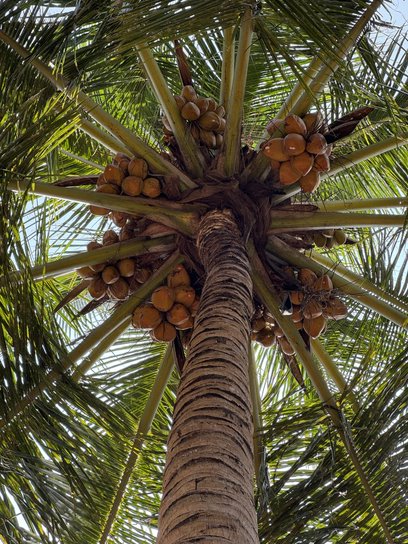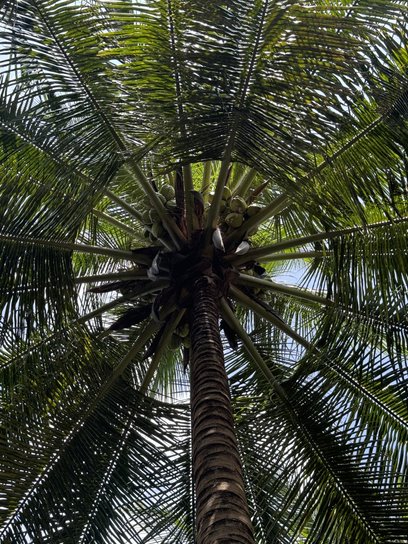Farming Coconuts
Posted by Coco Grove on Feb 4, 2025
Coconut Cultivation: A Detailed Guide from Seed Selection to First Harvest
Coconut cultivation is a systematic and long-term process requiring careful attention at every stage. The following steps outline the journey from selecting seeds to achieving the first harvest.
1. Selection of Planting Material
- Variety Selection:
- Choose a variety based on climatic conditions, soil type, and intended use.
- Tall Varieties: West Coast Tall, East Coast Tall. Suitable for oil production and coir industries.
- Dwarf Varieties: Chowghat Orange Dwarf, Malayan Dwarf. Ideal for tender coconuts and ornamental purposes.
- Hybrid Varieties: A combination of tall and dwarf, e.g., Kera Sankara, known for high yield and disease resistance.
- Choose a variety based on climatic conditions, soil type, and intended use.
- Seed Selection:
- Harvest mature coconuts (12 months old) from healthy, high-yielding palms.
- Nuts should weigh 600–700 grams with a uniform shape, size, and color.
- Nursery Bed Preparation:
- Prepare a raised bed (1.2 m wide, as long as needed) in a sunny location with sandy loam soil.
- Sow nuts horizontally, with the stalk end slightly raised, and space them 30 cm apart.
2. Raising Seedlings
- Care During Nursery Stage:
- Water the nursery regularly, ensuring the soil remains moist but not waterlogged.
- Shade young seedlings during extreme heat to prevent scorching.
- Weeding and Pest Control:
- Remove weeds manually to avoid competition for nutrients.
- Protect from pests like crickets and ants using bio-pesticides or chemical treatments as necessary.
- Seedling Selection:
- After 9–12 months, select vigorous seedlings:
- At least 6–8 healthy leaves.
- A robust root system with no signs of disease or pest damage.
- After 9–12 months, select vigorous seedlings:
3. Site Selection and Land Preparation
- Ideal Growing Conditions:
- Coconuts thrive in tropical climates with temperatures of 27°C–32°C, an annual rainfall of 1000–3000 mm, and altitudes up to 600 m above sea level.
- Soil should be well-drained, with a pH of 5.2–8.0. Sandy loam or alluvial soils are ideal.
- Land Preparation:
- Clear the land of weeds, stumps, and debris.
- For sloped areas, create terraces to prevent soil erosion and retain moisture.
- Pit Preparation:
- Dig pits of size 1m x 1m x 1m, spacing them 7.5–9 m apart for tall varieties or 6.5–7 m for dwarf varieties.
- Allow pits to weather for 2–4 weeks before planting.
4. Planting
- Season:
- The best time for planting is during the monsoon to ensure adequate soil moisture.
- Transplanting Seedlings:
- Place selected seedlings in the prepared pits.
- Ensure the collar region (where the stem meets the root) remains above ground level to prevent waterlogging.
- Fill the pits with a mixture of soil, organic manure (10–15 kg of FYM), and 1 kg of bone meal or neem cake.
- Initial Care:
- Water the newly planted seedlings immediately and mulch the base to conserve moisture.
5.Irrigation
- Water Requirements:
- Young palms require frequent watering (every 4–7 days) during the dry season.
- Mature palms can be irrigated every 10–15 days, depending on soil moisture and rainfall.
- Drip Irrigation:
- Highly recommended for coconut farming as it ensures efficient water use while maintaining consistent moisture levels.
6. Nutrient Management
- Fertilizer Application:
- Young Palms:
- Yearly application: 500g Nitrogen (N), 320g Phosphorus (P), 1200g Potassium (K).
- Mature Palms:
- 550g N, 340g P, and 1450g K per tree annually, split into three doses.
- Young Palms:
- Organic Inputs:
- Incorporate organic manure, compost, green manure, and bio-fertilizers to improve soil health.
- Apply neem cake to control soil-borne pests.
- Micronutrients:
- Supplement with magnesium, zinc, and boron as needed, based on soil testing.
7. Weed and Pest Management
- Weed Control:
- Manual weeding or the use of herbicides can help maintain a clean plantation.
- Pest Management:
- Common pests include:
- Rhinoceros Beetle: Controlled using traps or neem-based pesticides.
- Red Palm Weevil: Use pheromone traps and destroy infected parts.
- Maintain plantation hygiene to reduce pest infestation.
- Common pests include:
- Disease Control:
- Address root wilt and bud rot by using appropriate fungicides and maintaining proper drainage.
8. Intercropping
- Maximizing Land Use:
- During the first 3–5 years, grow short-duration crops such as bananas, pineapples, or legumes between the rows.
- These crops enhance soil fertility and provide additional income.
9. Mulching and Soil Conservation
- Mulching:
- Use coconut husks, leaves, or other organic matter around the base of the palms.
- Mulching helps retain soil moisture, suppress weeds, and regulate soil temperature.
- Soil Erosion Control:
- On sloping terrains, plant cover crops like cowpea or groundnuts to prevent erosion.
10. Pruning and Maintenance
- Pruning:
- Remove dried, diseased, or low-hanging fronds periodically to maintain palm health.
- Maintenance:
- Regularly inspect for pests and diseases.
- Replenish soil nutrients and ensure proper irrigation.
11. First Harvest
Coconut farming is a rewarding venture that requires diligent care, from selecting the right seeds to managing the plantation meticulously. Each stage, from nursery preparation to pest management and harvesting, plays a crucial role in ensuring healthy palms and high yields. Proper planning and adherence to best practices can make coconut cultivation a sustainable and profitable endeavor.
For further support contact community@cocogrove.in


